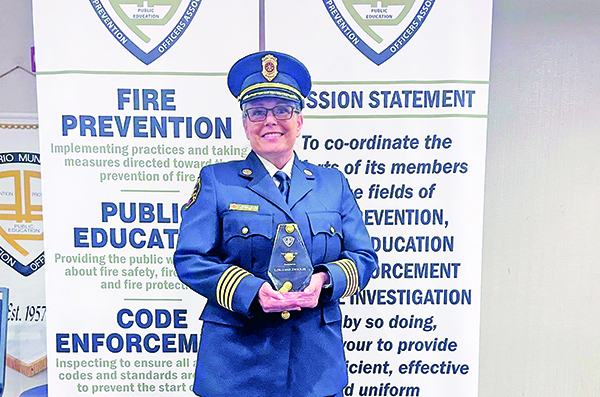General News » News
CYFS’ Zwicker named Fire Chief of the Year by Provincial organization
June 20, 2025 · 0 Comments

Central York Fire Services Deputy Chief Lorianne Zwicker has been named Fire Chief of the Year by the Ontario Municipal Fire Prevention Officers Association.
The honour recognizes a Chief each year who has made “significant contributions to Fire Prevention, Community Risk, and Public Education,” all of which are passions for Zwicker.
Zwicker joined Central York Fire Services (CYFS) this past January, coming to the fire service shared by Aurora and Newmarket after careers in Toronto, Barrie and Georgina.
She is the first woman to hold a Senior Officer position within the CYFS since its inception in 2002.
Zwicker was a school teacher before she decided to shift her career focus to the fire services, and is proud to continue her role as an educator both at the CYFS and within the Aurora and Newmarket communities on fire prevention and risk assessment.
“What I do every day is what I do every day,” says Zwicker. “To be recognized, I’m honoured and I was humbled at the same time because I know a lot of the Chiefs out there and I know we all put our best effort forward every day. I’m truly honoured [by the award] but a lot of it I owe to my teams in Georgina and Central York. I wouldn’t be able to do what I do every day without having the strength of the team behind me. They are the faces that everyone sees every day out there educating and also ensuring that buildings are safe when they’re doing their inspections.”
As a former teacher, education remains Zwicker’s first love and she has found opportunities to further that passion in the second chapter of her career.
“I was introduced to fire prevention and public education and that was it,” she recalls. “I’ve been very fortunate throughout my career to be an Inspector, to be an educator, and a Training Officer and I’ve had all the pieces that really promote fire safety, public education, but also training.”
This drive goes well beyond training her team and getting fire prevention tips out to the community. She has spearheaded Community Risk Assessment programs that are data-driven and updated daily, taking, for instance, a closer look on where fires are taking place, what’s causing them – cooking, smoking, or electrical fires – and using this data to develop targeted messaging to make residents aware of “the concerns that really affect them.”
“We may have open air burning in one area, but not in another area, so we can start to target messages to educate and it’s giving that community risk assessment even more power moving forward,” she says. “When I came [to CYFS] in January, Chief Rocco Volpe asked if I could [continue with this work] and with the incredible support of Newmarket’s IT team, I’ve been able to recreate [the assessments] and make it even better.
“The purpose of a Community Risk Assessment is that you need to use the data daily, watching that data, seeing what those changes are, and then we can go deeper.”
The deeper they analyze the data, the more targeted their approaches can be when it comes to fire prevention, and it also helps guide CYFS’ outreach when it comes to inspections, community partner development, and reaching out at the resident-level as part of their Stay Fire Smart Program, which sees Fire Prevention Officers fan out throughout the community to educate on the importance of keeping smoke and CO detectors up to date, while also helping residents conduct tests and replacements.
All of the data that has been collected so far, and will be collected throughout the summer, will help inform a National Research Project on determining the “why” in residential smoke alarm non-compliance.
“Change in behaviour is everything and it’s the basis of why we educate,” says Zwicker on smoke alarm compliance. “Number one, it’s the law; number two, we know it will save our lives. However, what are we doing that’s not getting that message across? We need to be able to find ways to educate the community, the residents, on the importance of smoke alarms and maintaining them.
“I’ve partnered with the National Research Council [on a study], and we finished Phase One, which was a survey of all Ontario municipalities [asking about their smoke alarm programs]. That information now has all been tallied and we’re going to be meeting next month with the Canadian Association of Fire Chiefs [where] we will present our data. We’re asking for their support to push it out to all of the other provinces so we will have a nationwide survey and data coming forward. From there, we’re going to look at solutions on what we’re doing now and what we can do better in the future to get that message out on the importance of working smoke alarms.
“I want to know why smoke alarms are not being maintained and that’s my number one priority over the next two years with the National Research Council: to really build something that any municipality can go into it, read it, understand the why, and give them tools to be able to build a better, stronger smoke alarm program.”
By Brock Weir












